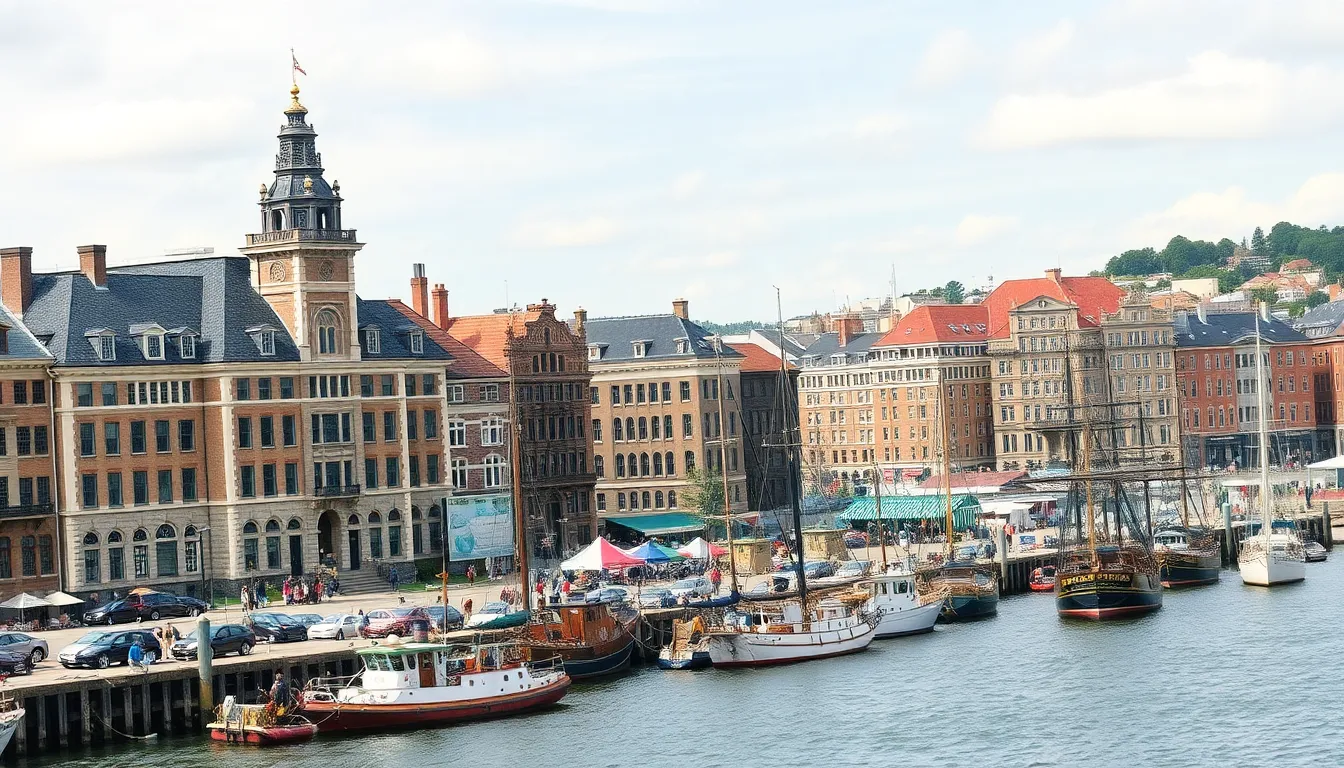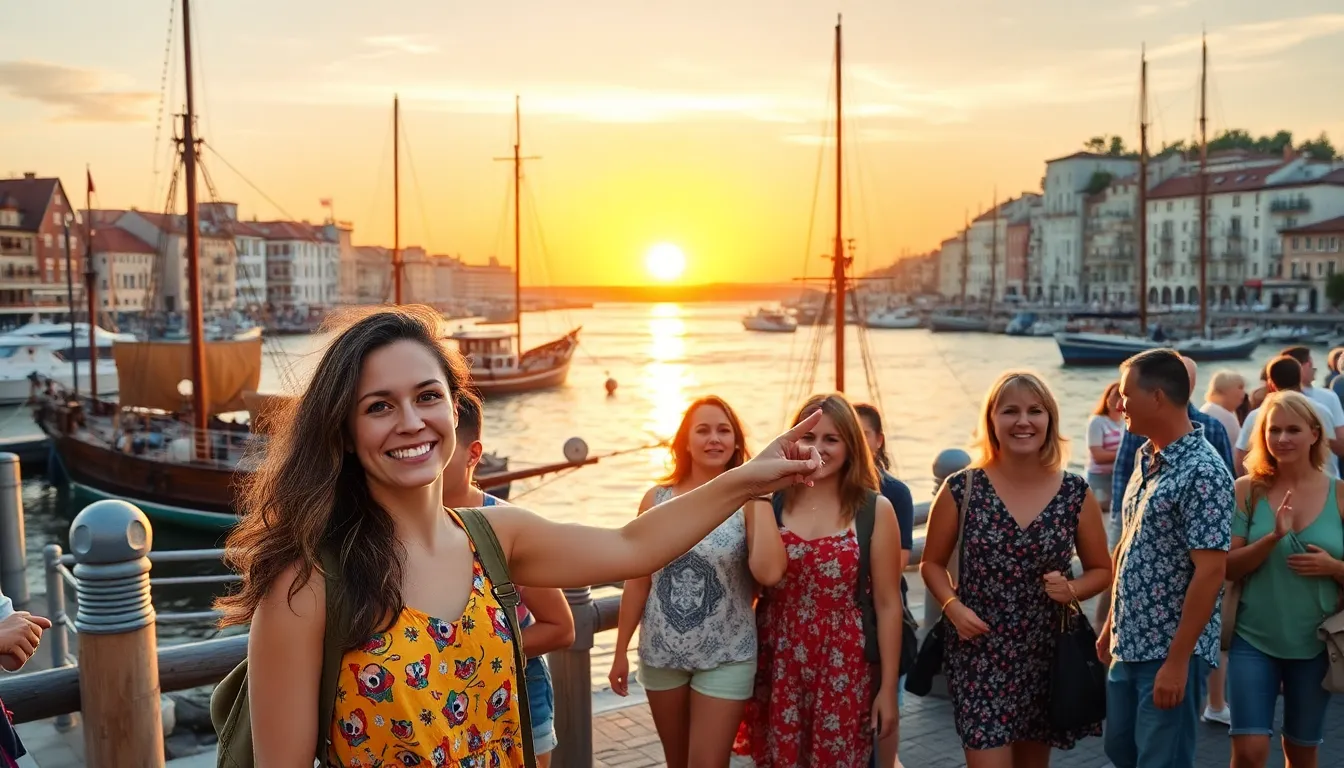From bustling ports to serene harbors, maritime history cities are where the past meets the present in a splash of adventure. These coastal gems not only boast stunning views but also carry tales of daring sailors, mysterious shipwrecks, and the occasional sea monster (or so the legends say). If you’ve ever dreamed of walking the same streets as those who navigated uncharted waters, now’s your chance.
Imagine sipping coffee at a waterfront café while listening to stories of pirates and explorers who once roamed the very docks you’re standing on. Each city has its own unique flavor, blending history with modern life in a way that’s as refreshing as a sea breeze. So grab your compass and set sail on a journey through these maritime marvels, where every wave whispers secrets of the past just waiting to be discovered.
Table of Contents
ToggleOverview of Maritime History Cities
Maritime history cities represent crucial centers of trade and cultural exchange. These locations often played significant roles in shaping regional economies and international relations. Cities like Boston, Massachusetts, once thrived on shipping and fishing industries, providing vibrant communities anchored in nautical heritage.
Numerous maritime history cities display their past through well-preserved architecture and museums. In Charleston, South Carolina, visitors explore the historic waterfront and engaging exhibits that reveal stories of early explorers and settlers. Similarly, San Francisco, California, showcases its maritime roots through landmarks like Fisherman’s Wharf and maritime museums.
Trade routes intersected in many of these cities, contributing to their growth and diversity. Seattle, Washington, emerged as a vital port city on the West Coast, while New Orleans, Louisiana, served as a key junction for goods moving along the Mississippi River. Each city has unique narratives tied to its seafaring past.
Festivals and events in maritime cities celebrate this history, attracting tourists and locals alike. The Tall Ships Festival in various locations often features majestic sailing vessels, representing heritage and craftsmanship. Historical reenactments also offer immersive experiences, bringing stories of maritime life to life.
Culinary adventures await in these cities, often featuring fresh seafood and dishes inspired by maritime culture. Portland, Maine, boasts a thriving lobster scene, while Galveston, Texas, serves up Gulf Coast specialties. Dining in these locales allows for a taste of the region’s maritime influences.
People exploring maritime history cities uncover layers of heritage and tradition. Each visit fosters an appreciation for the contributions these cities made to global history, inviting deeper connections with the past. Adventure and discovery lie around every corner, making these destinations a must-see for history enthusiasts and travelers alike.
Key Features of Maritime History Cities

Maritime history cities exhibit unique characteristics that highlight their coastal significance and rich cultural heritage. These features draw visitors eager to explore historical connections between the land and sea.
Importance of Location
Geographical positioning plays a vital role in defining maritime cities. Proximity to coastlines enabled trade routes and navigable waterways, fostering economic growth. For instance, Boston’s location along the Atlantic facilitated its development as a prominent shipping hub. Charleston benefits from its deep harbor, attracting vessels and merchants. San Francisco’s placement near the Pacific Ocean allowed it to become a critical point for maritime commerce during the Gold Rush. Seattle’s strategic positioning at Puget Sound enhances its role as a shipping and maritime logistics center. Each city’s location has shaped its identity and sustained its maritime legacy.
Architectural Influences
Maritime history cities showcase distinct architectural styles reflecting their nautical heritage. Structures often feature design elements inspired by maritime activities. Notable examples include Boston’s Federal style, which mirrors its shipping influence. Charleston’s historic homes exhibit Gothic and Colonial Revival styles, emphasizing its past as a trade port. San Francisco boasts Victorian buildings, reminiscent of its bustling harbor life. Seattle’s waterfront features modern architecture paired with influences from its maritime history. Each city weaves its architectural narrative, illustrating the legacy of seafaring and commerce.
Notable Maritime History Cities Worldwide
Maritime history cities blend rich trade heritage with vibrant cultural narratives. Explore these iconic locations that shaped global interactions and trade routes.
Amsterdam: A Hub of Trade
Amsterdam stands as a historical trade center, renowned for its canals and iconic gabled houses. The city played a crucial role during the Dutch Golden Age, facilitating international commerce through its strategic port. Merchants from various regions, including Asia and Africa, visited Amsterdam to exchange valuable goods. The city’s advanced shipping infrastructure contributed significantly to its prosperity and growth. The Rijksmuseum and the Maritime Museum showcase artifacts, highlighting Amsterdam’s naval prowess and trading legacy.
Venice: The Serenissima
Venice, known as La Serenissima, exemplifies maritime history with its unique network of canals. Once the heart of a powerful trading empire, Venice thrived on commerce between Europe and the East. The Grand Canal remains a bustling waterway, offering glimpses of the city’s architectural grandeur. Its iconic landmarks, like St. Mark’s Basilica and the Rialto Bridge, reflect a blend of cultural influences gained through maritime trade. Celebrated festivals such as the Venice Carnival further emphasize the city’s lively traditions linked to its seafaring past.
San Francisco: Gold Rush and Beyond
San Francisco emerged as a vital port city during the Gold Rush in the mid-19th century. This boom attracted fortune seekers from around the world, leading to rapid growth and cultural diversity. The city’s waterfront, especially Fisherman’s Wharf, showcases its maritime roots with a lively atmosphere. Notable attractions like the Golden Gate Bridge serve as symbols of engineering brilliance and historical significance. Museums such as the San Francisco Maritime National Historical Park highlight the region’s seafaring traditions and efforts in maritime preservation.
Cultural Impact of Maritime History
Maritime history profoundly influences cultural development in coastal cities. Trade routes established centuries ago paved the way for diverse cultures to intermingle. Explorers and traders shared not only goods but also traditions, arts, and languages, enriching local communities.
In cities like Boston, varied immigrant populations contributed to a unique cultural tapestry, where festivals, foods, and languages reflect maritime heritage. Rich historical narratives manifest in preserved architecture, memorials, and museums, showcasing local maritime legends and significant events. Charleston’s thriving arts scene features elements inspired by its nautical past, evident in the city’s literature and performing arts.
Culinary traditions also have roots in maritime history. Seafood festivals across these cities celebrate local catches, drawing crowds and promoting regional dishes. Each event fosters community spirit while keeping maritime customs alive. Festivals like the Tall Ships Festival showcase not only historical vessels but also the craftsmanship and artistry associated with maritime endeavors.
Educational initiatives in these cities promote awareness of their maritime legacies. Museums host programs and exhibitions, engaging both residents and visitors in interactive experiences. Schools incorporate local maritime history into their curriculums, ensuring younger generations appreciate their shared heritage.
Global examples further emphasize the cultural impact of maritime history. Amsterdam’s canals reveal a legacy of trade that continues to shape its identity. Venice’s unique waterways echo the whispers of its trading past, making it a living testament to maritime influences. Through exploration and engagement with these cities, individuals connect with rich histories that shape contemporary culture. Discovering maritime history cities offers more than picturesque views; it provides a deeper understanding of human connections across time.
Challenges Facing Maritime History Cities Today
Maritime history cities encounter various challenges affecting their preservation and growth. Economic pressures impact funding for the maintenance of historical sites and museums, making it difficult to uphold the character of these locations. Many cities rely on tourism for revenue, which fluctuates based on global events and travel trends. Competing modern developments often overshadow historical landmarks, leading to potential neglect of cultural practices.
Environmental concerns pose significant risks as rising sea levels threaten coastal infrastructures. Hurricanes and storms can inflict damage on both waterfront properties and historical sites. Balancing urban development with heritage conservation remains crucial for the sustainability of these cities.
Residents often struggle to engage with their maritime history, as younger generations may prioritize contemporary entertainment over cultural heritage. This disconnect can diminish local pride and awareness of maritime legacies. Educational programs targeting schools and community groups focus on fostering interest in maritime history while promoting preservation efforts.
Heritage tourism faces challenges related to maintaining authenticity while accommodating modern visitors. Striking a balance between visitor experiences and preserving the integrity of historic sites requires careful planning and community involvement. Collaboration between stakeholders, including local governments and preservation societies, is essential to address these challenges.
Changes in global shipping practices can also reshape the significance of these cities. Containerization and technological advancements in shipping create shifts in maritime trade routes, potentially reducing the role of historical ports. Urban planners must adapt to these evolving landscapes to ensure maritime history remains relevant and celebrated in contemporary society.
Maritime history cities offer a unique blend of adventure and culture that captivates visitors. Exploring these destinations reveals not just stunning views but also rich narratives that shaped the world. Each city serves as a living museum where history and modern life intertwine seamlessly.
As travelers delve into the past through architecture, festivals, and culinary experiences, they foster a deeper connection with these coastal gems. The ongoing efforts to preserve and celebrate maritime heritage ensure that future generations can appreciate the stories and traditions that define these vibrant communities. Whether it’s the bustling ports of Boston or the enchanting canals of Venice, maritime history cities continue to inspire and educate, making them essential stops on any travel itinerary.

